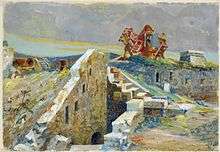Ray Howard-Jones
| Ray Howard-Jones | |
|---|---|
| Born |
30 May 1903 Lambourn, Berkshire |
| Died | 25 June 1996 (aged 93) |
| Nationality | British |
| Education | Slade School of Art |
| Known for | Painting, drawing |
Rosemary Howard-Jones, known as Ray Howard-Jones (30 May 1903 – 25 June 1996), was a prolific English painter best known for her impressionistic seascapes and paintings of the coastline of Wales, particularly of the areas around Skomer and Marloes.
Early life and education

Howard-Jones was born in Lambourn, Berkshire in 1903. Both her parents were Welsh and at the age of two the family moved to her grandfather's house in Penarth. Howard-Jones attended St.Hilda's School in Penarth and then the London Garden School.[1] In 1920 she went to the Slade School of Art in London, graduating four years later with a Fine Art Diploma that included distinctions in painting, wood engraving and design. She won the Slades summer composition prize for her oil Christ on the Road to Calvary. Howard-Jones went to work for the National Museum of Wales in Cardiff, providing drawings of archaeological reconstructions for the published works of Sir Cyril Fox and Dr Nash-Williams.[2]
World War II

In July 1942 Howard-Jones submitted 11 drawings to the War Artists' Advisory Committee which were not purchased and indeed were censored for the duration of the conflict. She submitted further drawings in November 1942 and July 1943 which were purchased and led to a commission to produce paintings of the fortifications on the islands of Flat Holm and Steep Holm in the Bristol Channel. Howard-Jones also painted scenes showing the preparations for D-Day taking place around Penarth and the Cardiff Docks. In all WAAC accepted fifteen paintings, including a portrait of her brother, a REME brigadier, to fulfill her commission. These paintings are now held by the Imperial War Museum and the National Army Museum.[3]
Post-war career
In 1946 Howard-Jones spent some time in Scotland at the art school run by James Cowie at Hospitalfield House.[1] In 1947 she moved to Ravenscourt Park in West London, where she stayed for the rest of her life, although she visited Wales every year with her partner, the photographer Raymond Moore, until they split in 1971. In 1958 she was commissioned to design a mosaic for the headquarters of the Western Mail in Cardiff. In 1965 she designed an mosaic altarpiece for the church of Marchmont St. Giles in Edinburgh.[4] In 1959 she had her first full show at the Leicester Galleries in London. Over the next ten years she was to have five shows there.[5] During the winter of 1963 she held a two-women show with Glenys Cour at the Attic Gallery in Swansea.[6]In all her work featured in almost thirty solo shows in Britain and her work is represented in galleries in both Australia and the United States. The Welsh Arts Council toured two retrospectives of her work, first in 1974 and again in 1983 and 1984. The Rocket Press organised a life-time retrospective of her work in 1993, which Howard-Jones attended and included works she had produced in her late eighties.[2] A volume of her poetry, Heart of the Rock: Poems by Ray Howard-Jones was published at the same time.[5]
Notable works
Howard-Jones' 1959 mosaic, "An Eye for the People", was created in Italy and installed on Thomson House, Cardiff, after the artist had won a Wales-wide competition in 1958.[7] The 35-feet high mosaic[8] included a giant blue eye which represented the role of the Western Mail newspaper in Wales.[7] After almost 50 years the mosaic and the building were demolished in 2008[8] before the Twentieth Century Society was able to save it. The Society described it as "one of the finest post-war mosaics in Britain".[7]
The only surviving mosaic of Howard-Jones is a 1955 altarpiece in Marchmont St Giles Parish Church, Edinburgh.[7]
References
- 1 2 David Buckman (1998). Artists in Britain Since 1945 Vol 1, A to L. Art Dictionaries Ltd. ISBN 0 95326 095 X.
- 1 2 David Stephenson & Lottie Hoare (27 June 1996). "Obituary: Ray Howard-Jones". The Independent. Retrieved 27 September 2013.
- ↑ Imperial War Museum. "Search the Collection: Ray Howard-Jones". Imperial War Museum. Retrieved 28 September 2013.
- ↑ Wales in Art. "Ray Howard-Jones". Wales in Art. Retrieved 27 September 2013.
- 1 2 Peter W Jones & Isabel Hitchman (2015). Post War to Post Modern:A Dictionary of Artists in Wales. Gomer Press. ISBN 978 184851 8766.
- ↑ Ceri Thomas, David Roe & Alexandra Roe (2012). The Attic Gallery at fifty. Attic Gallery. ISBN 9780957328402.
- 1 2 3 4 "29 Ray Howard Jones, An Eye for People, 1959". Twentieth Century Society. Retrieved 14 February 2016.
- 1 2 "20th Century Society Slams Destruction Of Public Artwork In Cardiff". Culture24. 14 November 2008. Retrieved 14 February 2016.
External links
| Wikimedia Commons has media related to Ray Howard-Jones. |
- Paintings by Ray Howard-Jones at the Art UK site